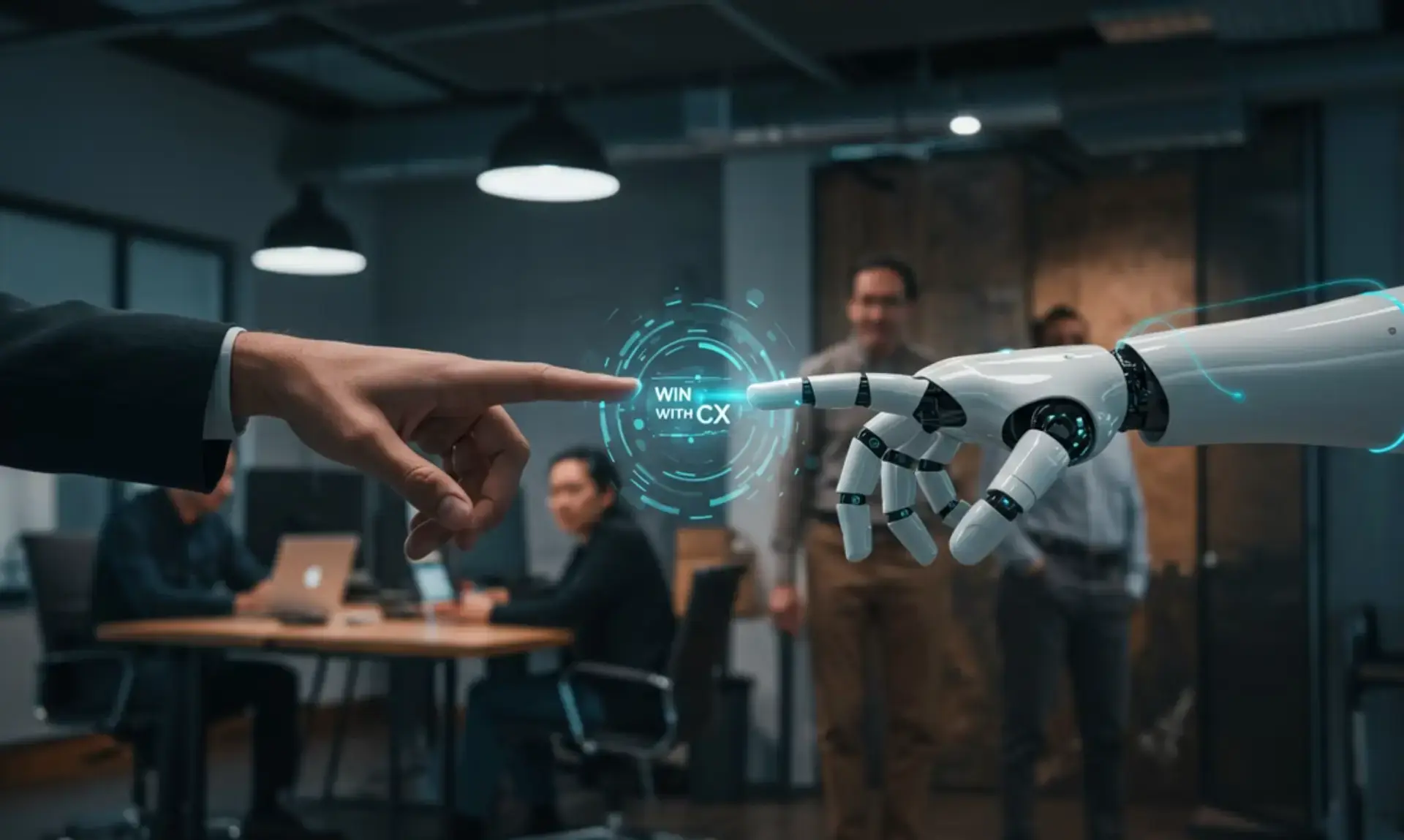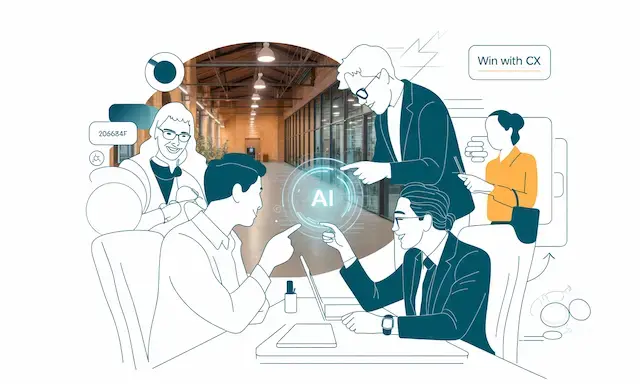At Win with CX, we’ve seen firsthand what happens when companies lean too heavily on AI: the experience crumbles. Customers get stuck in frustrating loops, struggling to find a real person when they need one–I’m sure many of you have experienced this situation. On the flip side, we’ve also seen what happens when businesses refuse to adopt AI and automation—costs increase, growth stalls, and employees are bogged down with repetitive tasks instead of delivering real value.
Anne and I were recently talking with a potential client who had just rolled out a chatbot to improve response times and route customers to the right department. Sounds great in theory. But in practice? Their CSAT scores dropped. Why? Because the chatbot lacked a clear escalation path. When it hit a wall, which happened often, it simply told customers, “Sorry, I can’t help you—try the regular support channels.” No warm handoff, no context passed along—just a dead end. Customers had to start over with a human agent, re-explaining everything. What was meant to improve the experience actually made it worse—and the data showed it.
And that’s not an isolated case. We worked with another organization that rushed to launch an AI-powered support bot, hoping to scale faster and reduce ticket volumes. But their internal knowledge base was a mess—outdated, inconsistent, and not structured in a way AI could use effectively. The tech was smart, but the content it relied on wasn’t—leading to a wave of inaccurate, unhelpful responses. Classic case of “garbage in, garbage out.”
What’s often missing in these scenarios is a human in the loop—someone to review responses, refine content, or audit the experience before it reaches the customer. With the right human oversight, that AI bot could’ve been a powerful asset instead of a liability. Because at the end of the day, AI doesn’t replace expertise—it needs to be guided by it.
The best CX strategies don’t pick one side or the other. They combine the efficiency of AI with the empathy and authenticity of humans, allowing each to do what they do best. This balance creates superior customer experiences, drives profitable growth, and empowers employees to focus on what truly matters.
A Harvard Business Review study involving 1,500 companies found that "the most significant performance improvements occur when humans and machines work together." This research confirms that tasks coming naturally to humans (like emotional understanding) may challenge machines, while tasks straightforward for machines (like analyzing vast data) can overwhelm humans.
|
AI |
Human |
AI + Human Collaboration (The Winning CX) |
|
Efficient at processing large datasets |
Excels in emotional intelligence and empathy |
Personalized experiences based on deep customer insights |
|
Automates repetitive, routine tasks |
Strong in critical thinking and creativity |
Enhanced problem-solving with authentic human connection |
|
Real-time analysis and instant responses |
Adaptive to complex, nuanced situations |
Smooth escalations, blending automation with human empathy |
|
Struggles with emotional understanding |
Struggles with scalability and data overload |
Balanced efficiency and authenticity, driving profitability |
The Four Pillars of AI-Enabled Customer Experience
An effective CX strategy comes down to four critical components, where AI and humans working together create something greater than either could alone:
1. Knowing Your Customer
AI can analyze vast amounts of data to identify trends, predict customer preferences, and provide insights humans simply don’t have time to process. But data alone doesn’t build relationships. Humans bring the emotional intelligence needed to interpret insights, personalize interactions, and create meaningful connections.
2. Providing Omnichannel Engagement
Today’s customers expect seamless interactions across multiple channels—chat, email, phone, social media, and more. AI helps optimize these touchpoints by assisting in interactions and ensuring customers get the right response, quickly. But when things get complex, humans step in to provide the empathy and problem-solving skills that technology lacks.
3. Empowering Employees
Employees who are drowning in repetitive tasks can’t deliver great CX. AI helps by analyzing customer feedback, identifying problem areas, and surfacing the right resources at the right time. When AI takes on the grunt work, humans are free to focus on high-value interactions—solving problems, building trust, and delivering standout service.
4. Improving Continuously
AI can monitor customer interactions in real tine, spotting friction points and areas for improvement. But the real magic happens when companies pair AI-driven insights with human judgment. Employees on the front lines provide context AI can’t, ensuring that improvements align with real-world customer needs and drive the intended changes.
Finding the Right Balance: AI and Humans as CX Partners
Relying too much on AI feels robotic and impersonal. Customers get stuck in frustrating loops, feeling unheard and undervalued. But ignoring AI and automation entirely is costly and unsustainable, creating inefficiencies that stand in the way of profitable growth. The best companies recognize that AI and humans aren’t competitors—they’re partners.
AI and humans each bring unique strengths to the customer experience, and the real magic happens when they work together. AI excels at efficiency—it processes vast amounts of data, identifies patterns, automates repetitive tasks, and provides real-time insights. It ensures speed, accuracy, and scalability, allowing businesses to optimize operations and respond quickly to customer needs. However, AI lacks the emotional intelligence, creativity, and adaptability that define exceptional customer interactions.
That’s where humans shine. People bring critical thinking, problem-solving, and the ability to navigate complex, nuanced situations. They build relationships, apply empathy, and adjust to real-time context in ways AI simply cannot. While AI ensures consistency and scale, humans provide authenticity, brand representation, and the personal touch that fosters loyalty.
By using AI to streamline processes, surface insights, and handle repetitive tasks, businesses give employees the time and space to focus on what they do best—building relationships, showing empathy, and solving complex problems. This isn’t about AI replacing humans. It’s about enabling people to do their best work and creating customer experiences that are smarter, faster, and more human than ever before.
Looking ahead, the economic implications of successful human-AI collaboration are substantial. Research suggests this partnership could unlock up to $15.7 trillion in global economic value by 2030. This potential will be realized by organizations that effectively measure and develop both human and AI capabilities, focusing on real-world skill application, proficiency, and lifelong learning.
Ready to Elevate Your Customer Experience?
At Win with CX, we help businesses strike the perfect balance between AI efficiency and human empathy and critical thinking to create experiences that drive loyalty, growth, and profitability.


.png?width=70&name=Dreamwave-Photo%20(8).png)

.webp)
.webp)